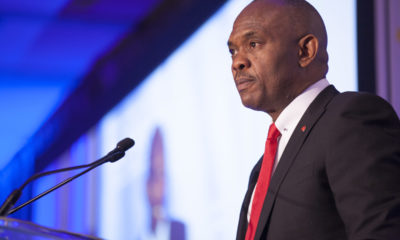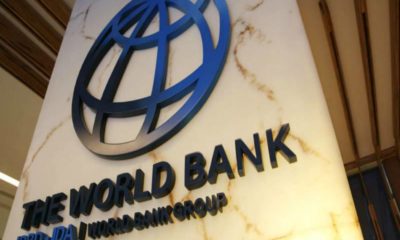Markets
Emefiele Optimistic About Rate Convergence as S&P Affirms Nigeria’s Ratings with Stable Outlook
Published
8 years agoon

- Emefiele Optimistic About Rate Convergence as S&P Affirms Nigeria’s Ratings with Stable Outlook
The Governor of the Central Bank of Nigeria (CBN), Mr. Godwin Emefiele, is upbeat about the convergence of the foreign exchange (FX) rates on the official and parallel markets, stating that the gains made by the naira against the greenback in the last five weeks were not a fluke.
Emefiele’s statement came just as global ratings agency, Standard & Poor’s (S&P), affirmed its ‘B/B’ long- and short-term sovereign credit ratings on Nigeria. S&P also stated that the country’s outlook remained stable.
Briefing journalists at the end of the two-day Monetary Policy Committee (MPC) meeting of the CBN, where the key policy rates were retained, Emefiele said he was happy that the central bank’s intervention was yielding positive results.
“I am happy, indeed very gratified, that the interventions have been positive, we have seen the rates now converging and we are strongly optimistic that the rates will converge further.
“In terms of sustainability, I think it’s important for us to say that the foreign reserves at this time are still trending upwards to almost $31 billion as I speak with you.
“And the fact that we have done this consistently for close to five weeks, should tell everybody or those who doubt the strength of the central bank to sustain this policy.
“For me, they are taking a risk and they will lose in their bid to place a wrong bet. The direction is that there is a determination to see to the convergence of those rates and with what we have seen so far, we are very optimistic that those rates will converge, and all the elements in the foreign exchange policy will no doubt be implemented,” he said.
The CBN governor also dismissed the notion that it was the National Economic Council (NEC) that directed the CBN to introduce the new policy actions in the FX market.
He said it was the central bank that made a presentation on the Nigerian economy and the FX market, after which NEC advised it to look at all the issues that had been discussed on the FX market.
“But of course, before then, we had started to see the depreciation of the naira particularly at the parallel market and we had taken a decision that there was the need to reverse the trend and that is the reason we started the FX intervention, and I am happy that those interventions have been very positive,” he said.
On the outcome of the MPC meeting, he said in consideration of the headwinds in the domestic economy and the uncertainties in the global environment, the committee in a vote of nine to one member decided to retain the Monetary Policy Rate (MPR) at 14 per cent alongside all other policy parameters.
The dissenting member of the committee, he disclosed, voted to raise the MPR.
Emefiele added that the Cash Reserve Ratio (CRR) and Liquidity Ratio (LR) were also retained at 22.5 per cent and 30 per cent, respectively.
The MPC also retained the asymmetric corridor at +200 and-500 basis point around the MPR.
The MPC, Emefiele explained, re-evaluated the implications of the continuing global uncertainties as reflected in the unfolding protectionist posture of the United States and some European countries; sustenance of the OPEC-Russian agreement to cut oil production beyond July 2017; sluggish global recovery and the strengthening U.S. dollar.
“The committee also evaluated other challenges confronting the domestic economy and the opportunities for achieving price stability, conducive to growth in 2017.
“In particular, the committee noted the persisting inflationary pressures; continuing output contraction; high unemployment rate; elevated demand pressure in the foreign exchange market; low credit to the real sector; and weakening financial system indicators, among others.
“Nonetheless, members welcomed the improved implementation of the foreign exchange policy that resulted in the naira’s recent appreciation.
“Similarly, the committee expressed satisfaction with the release of the Economic Recovery and Growth Plan and urged its speedy implementation with clear timelines and deliverables.
“On the strength of these developments, the committee felt inclined to maintain a hold on all policy parameters. Nevertheless, the committee noted the arguments for tightening policy which remained strong and persuasive.
“These include: the real policy rate which remains negative, the upper reference band for inflation remains substantially breached and elevated demand pressure in the foreign exchange market.
“The reality of the sustained pressure on prices (consumer prices and the naira exchange rate) cannot be ignored, given the central bank’s primary mandate of price stability,” Emefiele said.
According to him, the MPC noted that the moderation in inflation in February was due to the base effect as other parameters, particularly month-on-month CPI continued to rise.
Tightening at this time, Emefiele said, would portray the bank as being insensitive to growth.
“Also, deposit money banks (DMBs) may easily re-price their assets which would undermine financial stability. Besides, the committee noted the need to create binding restrictions on growth in narrow money and structural liquidity and the imperative of macroeconomic stability to achieving price stability conducive to growth.
“The committee also considered the arguments for loosening the stance of monetary policy, noting its desirability in stimulating aggregate demand if credit increased with lower rates of interest.
“It noted the arguments that a loose monetary policy was capable of delivering cheaper credit, making it more attractive for Nigerians to acquire assets, thus increasing wealth and stimulating aggregate spending and confidence by economic agents, which would eventually lead to lower non-performing loans in the system.
“However, the counterfactual arguments against loosening were anchored on the upward trending month-on-month inflation and its impact on the exchange rate.
“Loosening would thus worsen the already negative real interest rate, widen the interest rate spread and reverse the positive outlook for the current account position,” Emefiele explained.
On the outlook for financial stability, he said the MPC noted that the banking sector was becoming less resilient as a result of the adverse macroeconomic environment.
“Nevertheless, the MPC reiterated its resolve to continue to pursue financial system stability. To this end, the committee enjoined the management of the central bank to work with DMBs to promptly address rising NPLs, declining asset quality, credit concentration and high foreign exchange exposures,” Emefiele said.
As the CBN governor announced the outcome of the MPC meeting, the naira recorded its strongest daily gain against the US dollar on the parallel market on Tuesday, where it rose by N20 to close at N410 to the dollar, compared with N430 from the previous day.
Also, the buy rate of the naira climbed to N420 to the dollar Tuesday.
The sustained momentum of the naira was the fallout of the central bank’s resolve to continue to flood the interbank FX market with dollars, forcing black market operators and currency speculators to dump the greenback.
Nevertheless, the naira weakened to N307.50 to the dollar on the interbank market Tuesday.
Reacting to the outcome of the MPC meeting, the Chief Executive of Financial Derivatives Company Limited, Mr. Bismarck Rewane, said the wait-and-see approach came as no surprise and was based on the need to monitor the inflationary expectations as well as assess the impact of the current FX interventions.
“If they had the boldness and audacity, they should have brought down the interest rate. So, they didn’t do anything because they didn’t want to rock the boat,” Rewane said in a phone chat.
He, however, noted that the confirmation of a stable outlook by S&P for Nigeria was reassuring, especially at a time the country is trying to restore investor confidence.
“Furthermore, a gradual improvement in the GDP growth rate, increasing external reserves, and improved oil production also factored in the MPC’s decision.”
The CEO of Times Economics, Dr. Ogho Okiti, also pointed out that MPC decision was mostly based on concerns about inflation, the level of economic growth, fluctuation in crude oil prices, and the direction of government revenue.
“Maybe by the next MPC when we start seeing concrete direction in these economic indicators, they may then begin to reduce interest rate,” the economist stated.
To the Chief Economist, Africa, Standard Chartered Bank, Razia Khan, the big question for the MPC members was whether there would be any further policy pronouncements from the CBN, following the endorsement of a “flexible FX regime” in the federal government’s Economic Growth and Recovery Plan (ERGP) that was announced recently.
According to her, the CBN’s interpretation “of that FX flexibility (for now) appears to be a continuation of more frequent FX sales aimed at achieving eventual convergence of Nigeria’s different FX rates”.
She noted that the MPC members were still concerned about the month-on-month rise in inflation. “There is concern that easing now would weaken the real rate of interest and weaken the FX rate.
“Despite a turnaround in monetary aggregates in February, the MPC still signalled some concern about the growth of narrow money.
“Second, the MPC appears to have resisted pressure from the fiscal authorities for an easing of policy. By holding rates, and putting price stability at the centre of its ambition, the CBN could well be preparing for a more meaningful liberalisation, to come eventually, only when conditions are more conducive.
“The CBN appeared comfortable that its FX reserves position will be safeguarded even as it steps up the pace of FX intervention. Oil earnings are likely to provide a key test to this assumption.
“For now, however, the emphasis is very much on holding everything steady, and achieving more convergence between the different FX rates.
“Greater convergence appears to be a necessary pre-condition to any further FX market liberalisation,” Khan stated in a note Tuesday.
Meanwhile, S&P on Tuesday affirmed its ‘B/B’ long- and short-term sovereign credit ratings on Nigeria, with a stable outlook.
S&P, in a report on its assessment on Nigeria, also affirmed its long- and short-term national scale ratings on Nigeria at ‘ngBBB/ngA-2’, just as it maintained its transfer and convertibility on the country at ‘B’.
It, however, pointed out that the ratings on Nigeria were constrained by the country’s low level of economic wealth, as real GDP per capita trend growth rates below those of peers with similar levels of development, and future policy responses that may be difficult to predict because of the highly centralised political environment.
“We expect Nigeria’s economy to achieve a real GDP growth of 1.5 per cent in 2017 and 3.4 per cent on average over 2017-2020, supported by improvements in the oil sector and improved government budget execution under its recently released Economic Recovery and Growth Plan (ERGP) 2017-2020.
“A gradual increase in foreign currency inflows through rising export revenues and government external borrowing could help reduce foreign currency shortages in the non-oil sector and allow industry and financial sectors more leeway to contribute to economic growth,” S&P added.
S&P stressed that Nigeria has significant infrastructure and energy shortfalls and low income levels, with GDP per capita at $1,800 in 2017.
“Although oil revenues support the economy when prices are high, we view them as exposing Nigeria to significant volatility in terms of trade and the government to swings in the revenue base.
“Nevertheless, the oil sector has a significant indirect impact on the economy. A marked contraction in oil production, slower implementation of fiscal policy, and a restrictive exchange-rate regime resulted in Nigeria’s economy contracting, in real terms, by 1.5 per cent of GDP in 2016.
“Since then, oil production has increased back above two million barrels per day (bpd) in early 2017 (against the about 1.6 million bpd reported at times in the second half of 2016).
“Oil production has been supported by reduced incidents of sabotage in the Niger Delta as the government’s engagement with community leaders appears to have borne fruit, while repairs are being completed on key export pipelines,” it added.
To this end, S&P marginally increased its oil price assumptions to an average $53 per barrel (/bbl) over 2017-2020, compared with $51/bbl in its previous review in September 2016.
“Overall, we forecast that Nigeria’s general government debt stock (consolidating debt at the federal, state, and local government levels) will average 23 per cent of GDP for 2017-2020, comparing favorably with peer countries’ ratios.
“We also anticipate that general government debt, net of liquid assets, will average 16 per cent of GDP in 2017-2020. We include debt of the Asset Management Corporation of Nigeria (around five per cent of GDP)–created to resolve the non-performing loan assets of the Nigerian banks–in our calculation of gross and net debt, in line with our treatment of such entities elsewhere.
“Over 80 per cent of government debt is denominated in naira. Despite the low government debt stock, general government debt-servicing costs as a percent of revenues are high and have increased in recent years from below 10 per cent in 2014 to our projection of 18 per cent on average in 2017-2020,” it added.
Furthermore, S&P noted that despite changes to the CBN FX policy, the country still maintains FX controls on both current and capital transactions, including import restrictions on 41 categories of goods.
It also stated that banks continue to face shortage of US dollars, “which has caused them to shrink the volume of letters of credit they could extend to their customers and for some of them to restructure or pay back their facilities as correspondent banks tested their ability to pay”.
“The central bank has recently started to provide additional U.S. dollars to the banks, and to private individuals at a rate up to 20 per cent higher than the official rate. However, in the event of devaluation, banks’ asset quality and capitalisation would be further constrained.
“We believe at least three banks are within 150 basis points of their minimum capital adequacy ratio owing to the 2016 devaluation of the naira and weak earnings.
“Further losses or devaluation could trigger an element of regulatory forbearance within the sector. It is therefore likely that a few banks will either actively shrink their balance sheets or seek capital injections in 2017, which could prove difficult in the current market and economic environment.
“We forecast that the Nigerian banks will suffer increased credit losses of 3.5 to 4 per cent in 2017 in aggregate, after an anticipated three per cent in 2016. Asset quality problems are expected to be most pronounced from domestic oil companies, power companies, manufacturing, and real estate.
“We also see particular risk from borrowers of foreign currency without foreign currency receivables,” S&P added.
Is the CEO and Founder of Investors King Limited. He is a seasoned foreign exchange research analyst and a published author on Yahoo Finance, Business Insider, Nasdaq, Entrepreneur.com, Investorplace, and other prominent platforms. With over two decades of experience in global financial markets, Olukoya is well-recognized in the industry.

You may like
-
Tony Elumelu Calls on Nigerian Government to Harness Electricity Sector for $1 Trillion Economy
-
Nigeria Records $20.93bn Personal Remittances in 2024 as Capital Account Surges
-
Trump’s 14% Tariff on Nigerian Imports Raises Fresh Concerns for Trade and Economic Stability
-
Nigeria Secures $1.08 Billion World Bank Support to Boost Education and Combat Malnutrition
-
Trump Declares Economic Emergency Introduces Tariffs on Nigerian Exports
-
Nigeria, Brazil Partner on $1.1bn Agricultural Revolution Plan













